 Friday - May 25, 2012
Friday - May 25, 2012
On The Edge Of A Milestone African-American Achievement
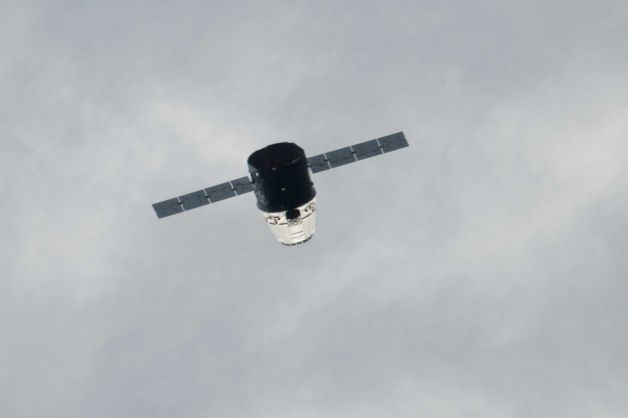
CAPE CANAVERAL, Fla. (AP) — The privately bankrolled Dragon capsule approached the International Space Station for a historic docking Friday after sailing through a practice rendezvous the day before.
The unmanned SpaceX Dragon was on track most of the morning to deliver a half-ton of supplies and become the first commercial vessel to visit the space station. But as the capsule drew within 100 feet, flight controllers commanded it to retreat.
The capsule backed off to 230 feet as the SpaceX company worked to resolve a problem with the on-board tracking sensors. Stray reflections from the Japanese part of the space station were interfering with the Dragon’s laser-based sensors, officials said. SpaceX mission controllers quickly fixed the trouble and resumed the docking operation.
On Thursday, the capsule came within 1½ miles of the space station in a practice fly-by. It returned to the neighborhood early Friday so Kuipers and U.S. astronaut Donald Pettit could capture it with a robot arm. First, the capsule went through a series of stop-and-go demonstrations to prove it was under good operating control.
NASA ordered extra checks of the Dragon’s imagers as the capsule drew ever closer to the space station, putting the entire operation slightly behind schedule. Given that the Dragon is a brand new type of vehicle and this is a test flight, the space agency said it wanted to proceed cautiously.
...
This is the first time a private company has launched a vessel to the space station, an achievement previously reserved for a small, elite group of government agencies.
...
The California-based SpaceX — officially known as Space Exploration Technologies Corp. — is one of several companies vying for the chance to launch Americans from their homeland. That ability ended with NASA’s final shuttle flight last summer. To get to the space station, NASA astronauts must go through Russia, an expensive and embarrassing situation for the U.S. after a half-century of orbital self-sufficiency.SpaceX’s billionaire maestro, Elon Musk, who helped create PayPal, said he can have astronauts riding his Dragon capsules to orbit in three or four years. His Falcon 9 rockets lift off from Cape Canaveral, Fla.

latest live blogging updates -
FRIDAY MORNING - Final Approach, Dragon Grapple
Around 2:00 AM Pacific/5:00 AM Eastern NASA will decide if Dragon is GO to move into the approach ellipsoid 1.4 kilometers around the space station. If Dragon is GO, after approximately one hour Dragon will move to a location 250 meters directly below the station. Dragon will then perform a series of maneuvers to show systems are operating as expected. If NASA is satisfied with the results of these many tests, Dragon will be allowed to perform the final approach to the space station.
Sometime around 6:00 AM Pacific/9:00 AM Eastern, astronauts on the space station will grapple Dragon with the space station’s robotic arm and the spacecraft will attach to the station.
Bayou Rocketry Blog has been following the Falcon 9/Dragon story since the beginning, and has some of the story of uber-geek Elon Musk:
It was bad SA television that gave Elon Musk part of his mysterious edge. As a 10-year-old he read whole volumes of the Encyclopaedia Britannica after emptying the family bookshelves — anything to avoid another episode of ChiPs or Die Man van Intersek.
Avoiding sports and bullies just as keenly, he sat alone in his boy cave at home in Pretoria, reading Jules Verne and playing Space Invaders. Now, 29 years later, Musk is still playing video games alone into the late hours of the night.
These days it is in a basement man cave in a leased mansion in Bel Air, California, where Musk, who sold his online payment system PayPal for R11bn in 2002, is plotting the future of the human race.
Sixteen months ago, the SA expat accomplished something only ever achieved by the governments of the US, Russia and China. He sent a spacecraft into orbit and then recovered it.
This Monday, he plans to change space flight forever, becoming the first entrepreneur to dock his own orbiter, Dragon, with the International Space Station.
And it literally is his spacecraft. Beyond founding his private SpaceX company in 2002, Musk likes to remind people that he is also the self-taught “chief designer” of the Falcon launch rockets and their Dragon capsules.
CrunchBase provides more info about Musk:
Elon Musk (born June 28,1971) is an entrepreneur and a co-founder of PayPal, Tesla Motors and Space Exploration Technologies. He is chairman/CEO of Tesla Motors and SpaceX, and chairman of SolarCity.
Musk was born and grew up in South Africa, the son of a South African engineer and a Canadian-born mother who has worked as a New York City dietitian and modeled for fun. His father inspired his love of technology and Musk bought his first computer at age 10 and taught himself how to program; by the age of 12 he sold his first commercial software, a space game called Blaster.
He immigrated to Canada in June 1989 at age 17. He left Canada in 1992 after getting a scholarship to study business and physics at the University of Pennsylvania. He earned an undergraduate degree in economics and stayed on another year to finish a second bachelor’s degree in physics. Musk then considered three areas he wanted to get into that were “important problems,” as he said later. “One was the Internet, one was clean energy, and one was space.
In 1995, Musk moved to California to enroll in a graduate program in high energy physics at Stanford, in which he stayed exactly two days before dropping out to start Zip2, which provided online content publishing software for news organizations. In 1999, Compaq’s AltaVista division acquired Zip2 for US$307 million in cash and US$34 million in stock options.
Genius, entrepreneur, billionaire, super geek, Silicon Valley legend, and maybe even the real Iron Man. Perhaps the greatest success story to come out of Africa in the 21st century, if not the 20th as well. A genuine African-American success story, one of almost literally stellar magnitude. You would think he’d be an inspiration to everyone, everywhere, and a real hero within the community.
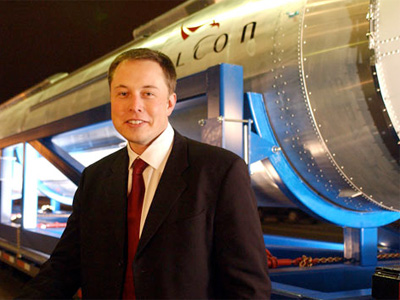
Elon Musk and one of his privately owned rocket ships
Oh. OH. Um, never mind.
UPDATE: GOTCHA!
Earlier this morning, the SpaceX Dragon capsule was successfully captured by the International Space Station Expedition 31 crew, making SpaceX the first commercial company to send a spacecraft to the ISS. The station’s robotic arm captured the Dragon at 9:56 a.m. ET after a journey that took three days, six hours, 11 minutes, and 23 seconds.
Dragon was later securely bolted to the Harmony module of the ISS at 12:02 p.m. ET.
Michael Suffredini, manager of the ISS program office, said he has talked many times about historic events and “this rates right at the top.”
“Having a contractor, relatively independent of NASA, design on its own a spacecraft that [they] tested and flew ... has been remarkable,” Suffredini said. “The spacecraft performed nearly flawlessly.”
Holly Ridings, NASA’s lead flight director for the SpaceX demo flight, added that it was a “really great day in space.”
Posted by Drew458
Filed Under: • Adventure • Africa • Space • Success Stories •
• Comments (5)
 Friday - March 02, 2012
Friday - March 02, 2012
Space Riddle
What’s the difference between the Moon and NASA’s cyber security?
The Moon is made of green cheese, and NASA’s security is made of Swiss cheese.
Lame humor, but come on. Swiss cheese is full of holes, just like their security. Horry Clap.
Chinese hackers gained control over NASA’s Jet Propulsion Laboratory (JPL) in November, which could have allowed them delete sensitive files, add user accounts to mission-critical systems, upload hacking tools, and more—all at a central repository of U.S. space technology, according to a report released Wednesday afternoon by the Office of the Inspector General.
That report revealed scant details of an ongoing investigation into the incident against the Pasadena, Calif., lab, noting only that cyberattacks against the JPL involved Chinese-based Internet Protocol (IP) addresses.
Paul K. Martin, NASA’s inspector general, put his conclusions bluntly.
“The attackers had full functional control over these networks,” he wrote.
What the flippin’ flippity flock???
“Some of these intrusions have affected thousands of NASA computers, caused significant disruption to mission operations, and resulted in the theft of export-controlled and otherwise sensitive data, with an estimated cost to NASA of more than $7 million,” Martin wrote.
“In 2010 and 2011, NASA reported 5,408 computer security incidents that resulted in the installation of malicious software on or unauthorized access to its systems,” his report states. “These incidents spanned a wide continuum from individuals testing their skill to break into NASA systems, to well-organized criminal enterprises hacking for profit.”
Other incidents “may have been sponsored by foreign intelligence services seeking to further their countries’ objectives,” he noted.
NASA offered a statement to FoxNews.com saying that there was never a threat to the International Space Station, but did not specifically address whether there was a threat to the Jet Propulsion Laboratory.
“NASA has made significant progress to better protect the agency’s IT systems and is in the process of implementing the recommendations made by the NASA Inspector General in this area,” Michael Cabbage, NASA spokesman said.
Which translates into normal English as “We’re totally screwed, our naked ass is hanging in the breeze bruised and bleeding, but we’ve finally figured out that we’ve been totally pwned for ages now, and are thinking about doing something about it.”
Holy fuck chunks on a greasy paper plate. Have you dweebs tried the most basic stuff, like isolating your systems, setting up a firewall, and catching the hundreds of Chinese spies you have working there as employees? Do you know how much it sucks to have to say “It’s not rocket science” to a bunch of rocket scientists? Sheez!!
NASA said it is aware of the problem and taking steps to improve its computer security programs.
Gosh, I’ll sleep better knowing that. Who the BLEEP BLEEP BLEEP s running security there, TSA? And why are we not hearing that the whole damn team has been fired and placed under arrest?
[case #184572 showing that China is actually an enemy, so let’s continue to send all our jobs and money to them. ASSHOLES.]
Posted by Drew458
Filed Under: • Computers and Cyberspace • Space •
• Comments (3)
 Tuesday - February 28, 2012
Tuesday - February 28, 2012
Close Call Next Year
Discovered 2012-02-23 by J75 OAM Observatory, La Sagra
Object is flagged as a Virtual Impactor by SENTRY (JPL)
NEODyS has posted 2012 DA14 as an impact risk.
... Classification: Apollo [NEO]
Earth Close-Approach 2013-Feb-15 19:25UT Nominal Distance (AU) 0.000217508367454278 AU =~ 0.085 Lunar Distance = * * close passer * *
absolute magnitude H = 24.243 roughly 45 meter diameter
I saw the edge of this story yesterday when posting about the visible planets being ... visible. I looked into it a bit more today, then was sidetracked for some time trying to make it fit the end of the Mayan calendar. Now them old Mayans didn’t seem to have watches, or even much in the way of horology, but they kept a pretty accurate calendar. The thing is rather like the odometer in your car, and it’s set to roll over during the 3rd week of December this year. End of the world? Well, maybe not. As far as I can tell, no Mayan legend foretells that; it’s just that the earth was destroyed by the gods the last 3 times their calendar flipped over, so go figure for this one. Anyway, the Mayan calendar dates back to the middle of August, 3114BC, though nobody knows when they actually built the thing; the crest of the Mayan civilization was 2000BC to 900AD. So trying to figure out if a minor error on their part - about 2.5 seconds per day, in a civilization without clocks - would push the “end of the world” forward 56 days to February 15/16 when this asteroid comes by. Those calculations turned out to be moot, since I have no idea when they actually started using thing. Furthermore, it seems they used both a 365 day solar year and a 260 regular year calendar at the same time, it’s numbering system being described in both Base 20 and Base 18 numbers simultaneously. And then it gets complicated.
But it struck me, as we stand here on the verge of yet another Leap Year’s Leap Day, that such a culture with a grand reputation for naked eye astronomy would have to use a solar dating far more accurate than just 365 days. We have Leap Year now, because we’ve figured out that a year is actually 365 and a quarter days ... for a nation of stargazers, their predictions would be off a full day every 4 years if they didn’t have something similar. And since they had writing, and watched the skies for several thousand years, they’d have to have had a higher level of accuracy even than that: the solar year is 365.256363 days long; that extra 0.006363 part adds up to more than 15 hours every century, which will throw your priestly prediction of eclipses and stuff off by quite a bit. It turns out we’ve been adding leap seconds here and there to our calendar, one or two or none per year, for the past 40 years. So our day keeping system isn’t exactly perfect either.
It’s not like I wanted to be able to bend things so I could play Nostradamus Junior and foretell the end of the world. It’s just that the calculated orbit of this new chunk of rock is accurate to within half an hour, and the minimum distance calculation shows it missing Earth ... by about 15 minutes. Oops. And the size calculation seems to be 45-90 meters, when the Tunguska Impact of 1908 - the one that leveled a good chunk of Siberia - appears to have been made by a 50-100 meter ice ball, delivering the kinetic energy of an H-bomb. Double oops. Even 1/8 of that would totally suck.
But back to the asteroid. 2012 DA14 - such a name, I guess Cassandra was taken? - is an unusual beastie. While many asteroids have highly elliptical orbits that take them out to the far corners of the solar system, or at least in and out of the Oort Cloud, DA14 seems to live pretty much on Earth’s orbital path. It’s an inner asteroid, with an orbit very much like our planet’s, except that it’s a bit off the solar plane.
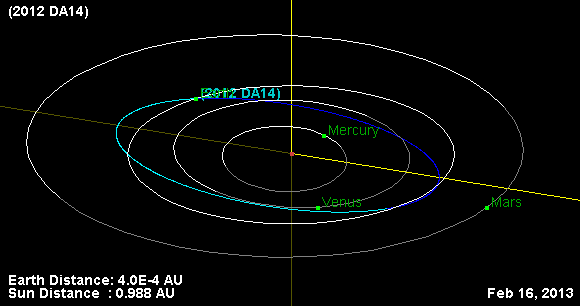
And the good news ... or at least they’re telling us it’s good news ... is that the closest approach, the minimum edge of the envelope, of this space potato will be about 26,900 kilometers, which is about 2.12 planetary diameters. This is actually well inside the orbital radius of all the geosynchronous satellites, which are out there at about 36,000 kilometers. So it’s going to be close. Razor burn close. But the smart boys and girls at JPL, NASA’s good buddies, where Rocket Science and Complex Mathematics truly are a matter of life and death, are giving the calculated Min/Max distances as 0.000180613845633866 AU and 0.00200199212143104 AU. 18 digit precision, thank you very much. Probably calculated in FORTRAN too! Too bad they define 1 AU as “approximately 150 million km”, which is not exactly confidence inspiring although it is scientifically honest, because the Earth’s orbit is slightly elliptical. Thank goodness they give us an Earth MOID of .000221174 AU (Minimum Object Intersection Distance), which means we’re safe by a whole 0.000040561AU, which is around 6084 kilometers, which is a bit LESS THAN HALF THE DIAMETER OF OUR PLANET.
Phew, for a second there, I was worried. Good thing NASA and JPL are on it, having made dozens of observations and calculations ever since this chunk of rock, which closely follows Earth’s orbit, years after year, century after century, was discovered all of last week. While they still have a 100% variation on the size of it, they’ve got it’s orbit figured out to the 18th decimal place, so sleep soundly.
According to scientists, asteroid 2012 DA14 has a length of 100 meters and in the case of hitting the Earth, can be released the energy, which equivalent to the explosion of the hydrogen bomb. On February 15, 2013 will be the first recorded case in which an asteroid can fly at a small distance from the Earth, we note, that the asteroid 2005 YU55, which caused the attention of scientists in November 2011, flew at a distance of 325 000 kilometers from Earth, more than 10 times higher, than the distance of the asteroid 2012 DA14, so some scientists do not rule out a collision the Earth with asteroid, because 27,000 kilometers - the distance, that may be in the range of errors of astronomical calculations, and this short distance is actually evidence of real probability of a collision, so other planets of the Solar system can change the trajectory of this asteroid.
obviously a Russian web page, and everybody knows you can’t trust those!
Posted by Drew458
Filed Under: • Space •
• Comments (1)
 Monday - February 27, 2012
Monday - February 27, 2012
Tonight After Sundown
Find a place where you can see the horizons, and take a look outside tonight right after sundown. If it’s clear where you are, you will be able to see at least 4 of the visible planets.
Tonight, you can see the moon above Jupiter and Venus in the west after sunset. And, from the Northern Hemisphere now, you can see all five visible planets sometime between sundown and late evening for the next several weeks.
...
Given an unobstructed horizon, Northern Hemisphere residents may see four of the five visible planets as soon as darkness falls. Look first for the waxing crescent moon above the dazzling planets Jupiter and Venus in your western sky. When it’s dark enough – perhaps 40 to 60 minutes after sundown – draw an imaginary line downward, using the moon, Jupiter and Venus, to locate Mercury near the western horizon.


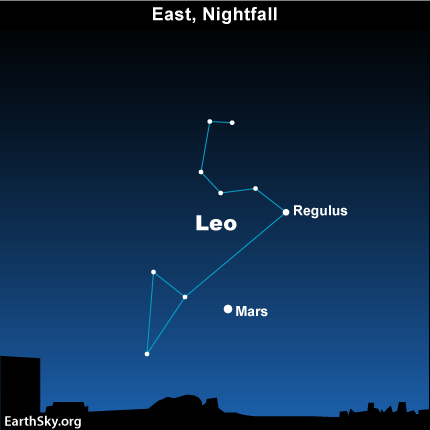
… stand in the place where you are, now face east
Once you’ve spotted these three, turn around and see red Mars low on the eastern horizon. Neat. Go inside now, but come back out before bed, around 10-11pm. Look to the east again, just a bit to the right of where you saw red Mars earlier and a hair lower in the sky. That golden colored “star” you see is Saturn.
Don’t worry if clouds are in the way of things tonight. This solar alignment will persist for another week or two. Actually, Mars will be at it’s closest point on March 3rd, so that night it will appear at its largest and brightest for the next 2 years.
I’ve been watching Venus and Jupiter dance with the moon for the past several nights. They’ve been quite brilliant in the clear sky. Tonight Mercury joins the mix, although you may have to go somewhere a bit higher up to see it clearly.
More info here. And more here!
Posted by Drew458
Filed Under: • Space •
• Comments (1)
 Wednesday - February 15, 2012
Wednesday - February 15, 2012
Leave it to the Swiss

Swiss scientists said Wednesday they plan to launch a “janitor satellite” specially designed to get rid of orbiting debris known as space junk.
The 10-million-franc ($11-million) satellite called CleanSpace One — the prototype for a family of such satellites — is being built by the Swiss Space Center at the Swiss Federal Institute for Technology in Lausanne, or EPFL.
EPFL said Wednesday its launch would come within three to five years and its first tasks are to grab two Swiss satellites launched in 2009 and 2010.
The U.S. space agency NASA says over 500,000 pieces of spent rocket stages, broken satellites and other debris are being tracked as they orbit Earth.
The debris travels at speeds approaching 17,500 miles per hour (28,000 kilometers per hour), fast enough to destroy or inflict costly and time-draining damage on a satellite or spacecraft. Collisions, in turn, generate more fragments floating in space.
CleanSpace One works by launching on a rocket, determining the trajectory of a piece of space debris it aims to “deorbit,” then approaching the junk by modifying its own course. It then grabs onto the garbage with pincers and soars back into Earth’s atmosphere, where it burns on reentry.
The satellite is small - only 10 cm by 10 cm by 30 cm. But its impact on space safety could be great. EPFL noted, “even a simple paint chip can seriously damage a solar panel or the window on a shuttle. To avoid the largest objects before they get critically close, the International Space Station must constantly alter its orbit. It managed to do this again just recently, on January 29, 2012.”
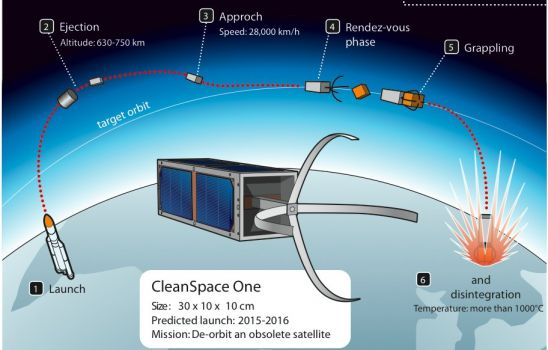
I think they’ve got their work cut out for them. Something that small won’t be able to carry enough fuel to move around much at all, and you’d have to launch thousands of them at once to make the rocket even close to cost effective. One scrubber satellite, one bit of space junk. Costly! I think a better idea is either a giant net thing, or put a few of those giant SDI S.M.I.T.E. lasers in orbit. Oh, don’t worry, Iran, we’re only using it to take out the trash. hur hur hur, get it? “Take out” the “trash”. Them mullahs got no sense of humor.
Old Dutch Girl icon is trademarked and owned by the Dial Corporation and has nothing to do with Switzerland or the CleanSpace satellite program as far as I know.
Posted by Drew458
Filed Under: • Space •
• Comments (0)
 Friday - January 27, 2012
Friday - January 27, 2012
Ro/Ro Row Your Boat

The Foss M/V Delata Mariner, launched in 1999, is a 312 foot long, 50 foot tall, 80 foot wide Roll On/Roll Off (Ro/Ro) carrier ship with an 8,000HP engine and just one job: it ferries giant missile engines, the Delta IV boosters used on the Space Shuttle and other rockets, from the Boeing factory in Decatur, Alabama down the Tennessee-Tombigbee waterway, into the Mississippi, past New Orleans and then across the Gulf of Mexico either around Florida and up to Cape Canaveral, or through the Panama Canal and north to Vandenburg AFB in California. And that is all that it does. It’s a rocket ship, even though it has a top speed of just 15 knots. Rocket transport ship that is.
Thursday night the ship was heading upriver, and it looks like it tried to go under the wrong span of the Eggner Ferry Bridge. Big mistake. The impact tore out one span of the bridge and rolled it up like a rug, roadway and all. Some hours later another span of the 1932 bridge also fell. No deaths or injuries; the old bridge doesn’t see much traffic and was nearly empty in the middle of the night when the accident occurred. One local man was driving on the bridge, but he managed to stop his pickup truck just in time.
The ship doesn’t even look all that damaged, but it will take some time to clean up the mess and fix the bridge.
AURORA, Ky. – State officials are inspecting what’s left of a southwestern Kentucky bridge that partially collapsed when it was struck by a cargo ship that was too tall to pass under the structure.
Pieces of the Eggner Ferry Bridge at Aurora, Ky., are strewn across the front of the motor vessel Delta Mariner as it sits at the site of a Thursday accident.
Two spans of the Eggner Ferry Bridge at US 68 and Kentucky 80 were destroyed Thursday night by the Delta Mariner. No injuries were reported on the bridge or in the boat.
The ship was traveling upriver toward the Kentucky Lock and Dam when it hit the aging steel bridge, which was built in the 1930s and handles about 2,800 vehicles a day.
On Friday morning, the front of the ship remained tangled with steel from the bridge and hunks of asphalt from the roadway. Kentucky Transportation Cabinet officials said inspectors began an in-depth review of the bridge at daylight.
“There is a point where they may have to disassemble the structure completely or use a crane to move the debris,” Jim LeFevre, highway department chief engineer, told The Paducah Sun. “That ship is going to be there for some time.”
Transportation Cabinet spokesman Keith Todd said he believes most [italics: Drew458] of the navigational lights were functioning on the bridge at the time of the impact.
“Our people talked to the Coast Guard as recently as Tuesday to update them on the navigational lights, and we believe most of them were working at the time of this wreck,” Todd said. “Although the green bridge marker lights on the bridge should have been visible from both sides of the bridge.”
The 312-foot-long cargo ship was built to navigate shallow waterways and was carrying empty rocket booster cores, Coast Guard Lt. Jason Franz told The Sun.
Interestingly, but only as one of those odd coincidences, the Foss company, which is a shipbuilder, a transportation support conglomerate, and the largest barge company on the west coast, also supports bridge construction. They helped build the Tacoma Narrows bridge, and they’ve also just released their new “green” hybrid tugboat, which utilizes their new and patented hybrid propulsion system.
The Eggner Bridge is in western Kentucky, southeast of Paducah, in that thin corner of the state between Tennessee and Illinois. No blame is being assessed at this point; perhaps the green lights were not lit under the higher spans of the bridge where this ship should have gone.
The transportation cabinet said the bridge was in the process of being replaced, and pre-construction work began months ago.
Another one of those happy coincidences I guess.

Posted by Drew458
Filed Under: • planes, trains, tanks, ships, machines, automobiles • Space •
• Comments (3)
 Friday - December 16, 2011
Friday - December 16, 2011
Space Scientists: We’ll Use The Chewbacca Defense On This One, Thanks
“If Chewbacca lives on Endor, you must acquit”
Just so you know, a comet generally goes along at about 18 miles a second. Ignoring for a moment the parts of it’s trajectory close to the corona on both the entry tangent and the exit tangent, it still took about 22 hours for comet Lovejoy to zip halfway around the sun just 87,000 miles about the surface (about a third of the distance between Earth and the Moon). A ball of ice. Flying through 2 million degrees of Hell for a whole day. And there was something left, AND it managed to break away from the Sun’s gravitational field. Now, getting back to those tangents: Mercury, the nearest planet to the Sun, has a wobbly orbit that averages a radius of about 36 million miles. 36 million miles out (23 days travel for a comet) the surface temperature of Mercury is 800° F, hot enough to melt lead and tin. And every mile closer to the Sun it gets hotter. Do your own math to figure out how far out from the Sun you have to go to find the point of state transition, when the temps get hot enough to melt ice and boil it away in the relative vacuum of space. Probably at least a week’s additional journey, both coming and going.
Oh, and all you Star Trek fans will know that to come out the other side, the comet had to pick up enough velocity to achieve solar escape velocity. Which is 384 miles per second. Which just also happens to be the escape velocity of the solar system, so this baby ain’t coming back.
Homework problem: assume what was left weighs in at 10 million tons on Earth. Traveling in an semi-circular arc of RSun + 87K miles at 384mps and in a gravitational field of GSun (the sun’s surface gravity is 28 times ours), compute the centrifugal forces applied to the comet on it’s trip. Try to rationalize how the comet held together when those forces were greater than the bond strength holding the atoms together.
Comet Lovejoy Survives Fiery Plunge Through Sun, NASA Says
A newfound comet defied long odds on Thursday, (Dec. 15), surviving a suicidal dive through the sun’s hellishly hot atmosphere, according to NASA scientists.
Comet Lovejoy plunged through the sun’s corona at about 7 p.m. EST (midnight GMT on Dec. 16), coming within 87,000 miles (140,000 kilometers) of our star’s surface. Temperatures in the corona can reach 2 million degrees Fahrenheit (1.1 million degrees Celsius), so most researchers expected the icy wanderer to be completely destroyed.
But Lovejoy proved to be made of tough stuff. A video taken by NASA’s Solar Dynamics Observatory (SDO) spacecraft showed the icy object emerging from behind the sun and zipping back off into space.
Naturally, stargazers and their gangs were expecting a fast melt and a puff of steam. What the hey, right, it’s only the sun. Um, nope, not this time.
SDO is one of many instruments that scientists — eager to record and study the comet’s presumed demise — trained on Lovejoy as it streaked toward the sun.
“We have here an exceptionally rare opportunity to observe the complete vaporization of a relatively large comet, and we have approximately 18 instruments on five different satellites that are trying to do just that,” Karl Battams, a scientist at the Naval Research Laboratory in Washington, D.C., wrote on the Sungrazing Comets website, before Lovejoy’s closest solar approach.
...
Battams greeted news of Lovejoy’s improbable escape with surprise and delight.“I expected a diffuse dust tail to survive (for several hours) before fading away but NOT any kind of nucleus!” he tweeted. “I’ve worked with sungrazers for 8yrs; today was the most amazing day I’ve ever had with them!”
Lovejoy has a core about 660 feet (200 meters) wide. It belongs to a class of comets known as Kreutz sungrazers, whose orbits bring them very close to the sun.
...
Lovejoy is quite large for a sungrazing comet, and experts expected it to die an impressive death. The website Spaceweather.com, for example, predicted Lovejoy would blaze as brightly as Jupiter or Venus in the sky as it neared the sun.Battams also expected a good show, saying the comet might even be visible from the ground around sunset today in the Northern Hemisphere.
“I do think that it will put on a spectacular show for us and will be the brightest Kreutz-group comet that SOHO has ever observed,” Battams wrote last week.
Though the early returns are still coming in, those forecasts appear to be on the money. Observations from various spacecraft do indeed show Lovejoy flaring up significantly as it neared our star.
Seems the comet left it’s tail behind. What’s just so darned amazing is that anything, anything AT ALL, came out the other side. Nearly a full month of ice melting temps coming in, and nearly a full month of temps hot enough to vaporize anything while going around. And there’s still a significant chunk of something left. If we still had a functioning space program, I’d want to send up a catcher satellite and grab a piece of whatever is left. That’s the stuff you want to build spaceships with, fer shure.
Lovejoy didn’t exactly come out of its hellish adventure unscathed. Only 10 percent of the comet — which was probably millions of tons — survived the encounter, said W. Dean Pesnell, project scientist for NASA’s Solar Dynamics Observatory, which tracked Lovejoy’s death-defying plunge.
And the comet lost something pretty important: its tail.
“It looks like the tail broke off and is stuck” in the sun’s magnetic field, Pesnell said.
Yeah, but something made it, when nothing should have. Scientists don’t have that answer yet, although they’re trying the “Gee, it must have been much much bigger than we thought” Giant Mass Excuse. Which is pretty much the Wookie Defense. Which means they just don’t know. “If the glove don’t fit, you must acquit.” Besides, the bigger the comet was, the larger the acceleration forces there would be as it went around.
Posted by Drew458
Filed Under: • Amazing Science and Discoveries • Space •
• Comments (6)
 Friday - September 16, 2011
Friday - September 16, 2011
Gee it’s good to be back home again
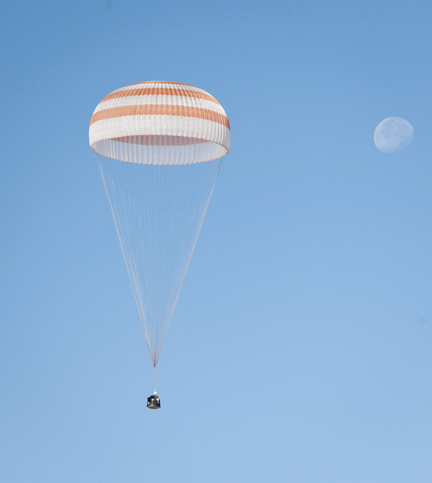
A Russian Soyuz capsule carrying three returning astronauts from the International Space Station touched down safely Friday in the central steppes of Kazakhstan, but not without rattling nerves after a breakdown in communications.
NASA astronaut Ron Garan and Russian cosmonauts Andrei Borisenko and Alexander Samokutyayev landed some 150 kilometers (93 miles) southeast of the city of Zhezkazgan at 10 a.m. local time (0400 GMT) after 164 days in space.
Repeated calls to the Soyuz TMA-21 capsule from Mission Control in Korolyov, outside Moscow, went unanswered for several minutes, well after the craft had de-orbited. Communication was eventually established between the crew and an Antonov fixed-winged aircraft circling the landing site.
The landing was smooth in the area planned seconds before the expected arrival time.
Russian cosmonaut Sergei Volkov, NASA’s Michael Fossum, and Satoshi Furukawa of Japan’s JAXA space agency remain onboard the international space station and are due to return to Earth on Nov. 22.
There will be some taut nerves in the run-up to that return, which Roscosmos announced Friday should be preceded by a manned Soyuz launch from Baikonur on Nov. 14. Earlier this week, Roscosmos announced that the launch was to take place on Nov. 12.
Russia’s space agency, Roscosmos, had to postpone that launch from October amid concerns over a failed supply mission last month. Another delay would almost certainly mean the space station would have to be left unmanned. Astronauts have been living aboard the station, without interruption, for almost 11 years.
Since phasing out the U.S. space shuttle program earlier this year, NASA is relying entirely on Russia to get American and other astronauts to the international space station.
The capsule landed gently around 30 seconds before 10 a.m. local time (0400 GMT) in the barren steppe, throwing up a puff of dust, before rolling onto its side.
While it is not unusual for the capsule to be pulled onto its side, it makes pulling out the crew a slightly lengthier process.
Good. Glad to hear this. And I’m sure their Space Pens are still working just fine too.
Meanwhile NASA - the New American Special muslim outreach Association - continues to bleed geeks, and it looks like their future will now be robotic instead of manned space flight. That is, when they aren’t busy learning how to bow towards Mecca.
Posted by Drew458
Filed Under: • Space •
• Comments (1)
 Monday - May 16, 2011
Monday - May 16, 2011
Once More Into The Blue
On its 16-day mission, Endeavor will deliver a cosmic ray detector to the space station, which scientists hope will give them a glimpse into the very first moments of the universe, just after the big bang. On board, the astronauts are all wearing the blue bracelets celebrating Giffords life.
The liftoff of Endeavor marks the beginning of the end of an era for the shuttle program. It’s the next to last launch. Atlantis lifts off in June, bringing the 30-year shuttle program to an end.
Hard to believe the US Space Program is getting ready to close down. Harder to believe what NASA’s new “mission” will be. Damn. I grew up with the voice of Mission Command and that age of glory. And now it’s all coming to an end. Budget cuts: the Democrats have always been against the space program, always. And honestly, after the moon landings, they’ve kind of been stuck in neutral for decades. As a junior rocketeer and a huge reader of sci-fi, I would have figured we’d have a profit making lunar colony by now, and men on mars. Alas no.
At T-9 minutes and holding, the STS-134 launch countdown continues its march toward liftoff of space shuttle Endeavour at 8:56:28 a.m. EDT.
During this hold, the mission management team will conduct their final “Go-No-Go” poll, and the countdown enters the home stretch.
“T minus 9”. Will future children even understand what that means?
The crew members for space shuttle Endeavour’s STS-134 mission are Commander Mark Kelly, Pilot Gregory H. Johnson and Mission Specialists Michael Fincke, Greg Chamitoff, Andrew Feustel and European Space Agency astronaut Roberto Vittori.
During the 16-day mission, Endeavour and its crew will deliver the Alpha Magnetic Spectrometer (AMS) and spare parts including two S-band communications antennas, a high-pressure gas tank and additional spare parts for Dextre.
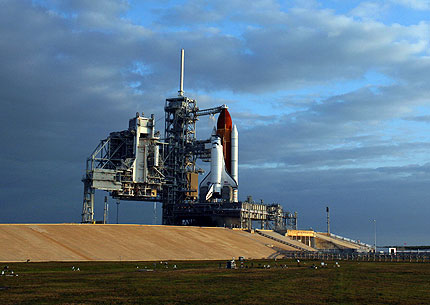
Final words from Commander Kelly: “We have always been a nation that reaches for the stars. We must not stop.”
Aw crap I’m getting all weepy here.
Godspeed, Endeavor.
All systems are go, the countdown runs down to zero, and we have ignition. And it’s a picture perfect launch. Endeavor blasts through some low level clouds and punches a hole in the sky, accelerating to faster than a speeding bullet within a minute, and reaching escape velocity in under 8 minutes. The boosters fall away without issue, and two minutes later the liquid fuel tank lets go without a hitch. After only 10 minutes flight Endeavor is in space, hundreds and hundreds of miles downrange. Now the steady 3G acceleration eases, and the computers arc the ship from an elliptical orbit into a circular one, 136 miles up above the sky.
For this, the 26th Shuttle mission, everything is nominal. That’s another word that is going to fade out of our language, or at least that usage. Only NASA could make “being trifling in comparison with the actual value; minimal” mean “letter perfect in every way shape or form” because with good engineering that’s only to be expected. No magic, no miracle, merely working as designed. Nominal. Even though a miracle is occurring. No wonder the Space Program was a reflection of national confidence. And no wonder such a program had to be eliminated by our twisted leaders, if for no other reason than that.
Posted by Drew458
Filed Under: • Space •
• Comments (5)
 Tuesday - April 05, 2011
Tuesday - April 05, 2011
A Close Shave In Space
A new analysis of a piece of Chinese space junk zooming so close to the International Space Station today that its crew prepared to take shelter in a Russian lifeboat has revealed that the satellite debris poses no risk to the orbiting lab or its astronauts, NASA officials said.
“Tracking data now indicates that a piece of orbital debris being monitored by Mission Control Houston will not pass close enough to the International Space Station to warrant the Expedition 27 crew members taking safe haven within their Soyuz TMA-20 spacecraft,” NASA officials said in an afternoon status update.
The space junk is a piece of China’s defunct weather satellite Fengyun-1C, which was destroyed during a Chinese anti-satellite test in 2007 that created a vast cloud of orbital debris, NASA officials said.
Based on the refined analysis, NASA officials said the satellite debris will fly within about 3.3 miles (5.3 kilometers) during its closest approach to the space station at 4:21 p.m. EDT (2021 GMT). It is approaching the space station from the front, but poses no danger of impacting the spacecraft.
Flight controllers had been tracking the debris all day from NASA’s space station Mission Control room at the Johnson Space Center in Houston to determine the potential risk it posted to the station and its crew. At about 7 a.m. EDT (1100 GMT), Mission Control radioed the station astronauts to tell them they may need to seek shelter in the Soyuz until the debris passes the space station.
“The probability of a collision became low enough that it wasn’t a high enough risk that we would need to shelter in place,” NASA spokesman Kelly Humpries told SPACE.com. Mission Control radioed the all-clear to the crew at 2:41 p.m. EDT (1841 GMT) as the space station sailed 220 miles (354 km) above eastern Asia.
Sure, sure, that’s what they say now. Earlier today it was lifeboat drill time.
A piece of space junk from a Chinese anti-satellite test will fly uncomfortably close to the International Space Station today, forcing the outpost’s crew to take shelter in a Russian lifeboat as a safety measure, NASA officials said.
The threatening space debris will zoom within 2.7 miles (4.5 kilometers) when it makes its closest approach at about 4:21 p.m. EDT (2021 GMT) today, NASA spokesman Josh Byerly told SPACE.com from the agency’s Johnson Space Center in Houston.
The station’s three-person crew includes NASA astronaut Cady Colman, Italian astronaut Paolo Nespoli and Russian cosmonaut Dmitry Kondratyev, who is commanding the mission. The astronauts and cosmonaut will close hatches between modules of the station’s U.S. segment, and take shelter in their Soyuz TMA-20 spacecraft, which can double as a lifeboat in case the debris actually strikes the space station and forces the crew to flee.
NASA is keeping a close eye on the space debris to make sure it passes by the space station without incident.
The space debris is a piece of China’s defunct weather satellite Fengyun-1C, which was destroyed during a Chinese anti-satellite test in 2007 that created a vast cloud of orbital debris, NASA officials said.
There are something like 22,000 bits of garbage floating around up there. Any one of them can cause a lethal impact, seeing as they’re flying around at thousands of miles an hour. Even when countries are nice and take out the trash, like Japan did last week there’s still a lot left. We need some kind of zero gravity litter picker up there.
Posted by Drew458
Filed Under: • Space •
• Comments (2)
 Friday - February 11, 2011
Friday - February 11, 2011
Oh GAK
NASA takes first step in their new role as islamic ambassadors.
Cairo, 10 Feb. (AKI) - The United States space agency NASA has okayed the naming of one of its spaceships after a young Egyptian woman killed in late January during an anti-goverment protest, according to Egyptian daily Al-Masry-al-Youm.
The paper quoted Essam Mohamed Haji, a young researcher at NASA as saying on Thursday he had received approval to put the young woman Sally Zahran’s name on a spaceship heading for Mars.
Zahran, a 23 English graduated and translator died after she was beaten about the head on 28 January with a truncheons during clashes with security forces in in the Upper Egyptian governorate of Sohag. Anti-government protesters claim her killers were thugs in the pay of police.
“This is the least we could provide to Egyptian youth and revolutionaries. This step represents transferring the dreams of Egyptian youth from a small stretch of earth to the enormous expanse of space,” said Haji was cited as telling Al-Masri Al-Youm by phone from California.
What the fuck is this saccharin dhimmi bullshit? Will the Navy now be naming it’s next ship the USS St. Pancake?
Posted by Drew458
Filed Under: • RoPMA • Space •
• Comments (2)
 Wednesday - December 15, 2010
Wednesday - December 15, 2010
Up, up, and away!
While the utterly disgusting, 2000 page, rape of the American-people, 20,000+ earmark filled pile of waste wends it’s way through the legislature, weighed down with nearly HALF A TRILLION DOLLARS in pork spending ($300 billion as of last night, $417 billion as of this afternoon, by tomorrow, who knows?), a boring, dull, and completely unspectacular Soyuz rocket launch has just taken place at the Baikonor Cosmodrome in Kazakhstan.
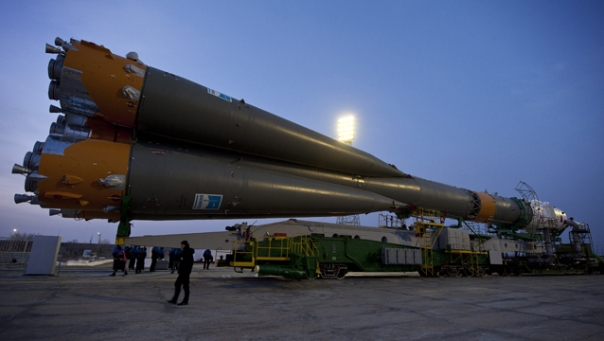
Russia’s Soyuz spacecraft blasted off on its latest mission, to deliver Russia, European, American and Japanese astronauts to the International Space Station.
The launch, which took place at 2:09 pm EST from the Baikonur cosmodrome on the steppes of Kazakhstan, came despite worries about the re-entry module of the Soyuz craft, which was hastily replaced earlier this month after it was damaged during unloading at the remote Russian launch site.
Russia’s Dmitry Kondratyev, NASA astronaut Catherine Coleman and the European Space Agency’s Paolo Nespoli of Italy will spend five months at the space station, which has a full schedule for 2011, with the arrival of several cargo craft delivered by the U.S., Russian, European and Japanese space agencies.
To this 60’s child of the Cold War and the Space Race, the whole event was both chilling and boring. The Reds wheeled out their gigantic rocket, broke it while setting it up (typical), so they rooted around their closet and got out another one. They have whole piles of these things just sitting around? Yikes. So they truck one out yesterday, and this afternoon they light it off. And it works just fine.
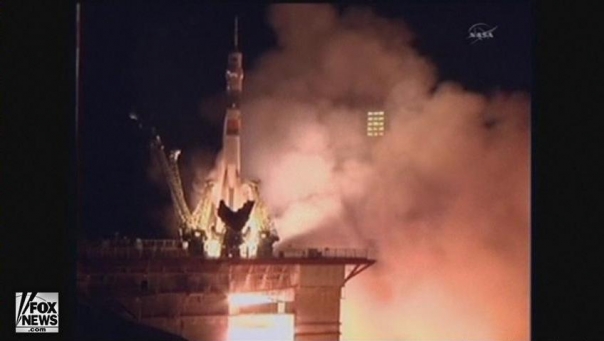
Am I the only one who finds this a bit disquieting? Seems to me that NASA always built theirs right on site, and then spent a couple days moving the thing, standing up on it’s launchpad, the mile or two to the ignition spot. Readying the massive rocket for flight then took several more days. Not the Russkis. Hell no. They just drive one in on a truck, tip it up, gas it and go. That fast. Glad it’s only people that they’re putting up. This time.
During their long-duration mission, Coleman, Kondratyev and Nespoli will participate in a range of scientific research and experiments, including fluid physics, radiation, biology, technology demonstrations and education outreach. Cosmonauts Kondratyev and Skripochka are also scheduled to perform at least one spacewalk to perform maintenance activities on the station’s exterior.
The whole liftoff scene was a let down too. Olga from Tractor Factory #4 was the voice of Mission Control. No countdown. No multiple camera angles. No interview with officials inside the Command Center with all those guys smoking in front of their computer monitors. No big orbital map with that sinusoidal launch path done up in little lights. This was a night launch, in Kazakhstan, so I’d expect either total darkness, one bare ass light bulb on a wire, or bank after bank of stadium lights. Nope. One rack, 20 bulbs. No “[beep] We have ignition. [beep]”. Nyet. The engines fired up, and 3 seconds later the gantries jumped away and the beast took flight. From the one fixed camera we had about 6 seconds of launching rocket footage, then nothing but a big white flair of rocket exhaust. Up, up, up ... and gone. And that was that. No 2nd stage ignition camera either. And Olga didn’t even ask “What about moose and squirrel?”! Sigh.
Our own TV people didn’t provide any color either. Not that they were there. No one was actually there. Probably forbidden, even if anyone could actually find Kazakhstan and figure out how to get there. But they could have mentioned at least that some school kids who had won some contest were on hand to watch, or that Italian astronaut Paolo Napoli was a bit upset that the Russians overcooked his pre-flight fettuccine until it was like chewing gum.
“The problem is that, as Italians, we have a very strict way of eating, and that breakfast broke every single rule that we have,” Mr Nespoli said at the Baikonur launch site in Kazakhstan.
Maybe he should have asked for turnips and potatoes.
And how is Obama’s decision to save money by turning NASA into a zero gravity muslim outreach community center working? Um, it’s doubled the costs, so far!
Russia profited handsomely from that monopolist position when it signed contracts for carrying NASA astronauts to the space station up to the end of 2014. A round-trip ticket to the space station in 2011 and 2012 will cost NASA as much as $51 million, up from the current $26 million. The price will jump to $56 million in 2013 and 2014.
And the budget bill? It’s just gross. It looks like the powers that be in DC think they can ignore the message the Tea Party sent them in November. Bloat, fat, graft, and nonsense. Oh, we’ll keep the evil Bush Tax Cuts For The Rich, but with a few caveats, like a 35% Inheritance Tax. And they’re keeping that idiotic corn liquor Ethanol subsidy, that costs you 45¢ a gallon at the pump. You know, the farm subsidy program that was at the very top of the list of Things To Cut? Yup, it’s still there. Plus, now we learn that the Feds are trying to steal a whole bunch of land as part of the deal too. Does that look like “message received” to you?
Tea Party: our work is just beginning.
Posted by Drew458
Filed Under: • Economics • Government • Space •
• Comments (4)
 Wednesday - May 26, 2010
Wednesday - May 26, 2010
Gliding Into Retirement
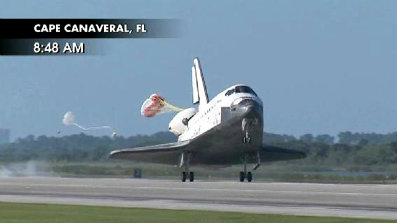
After 32 flights, space shuttle Atlantis returned safely to earth this morning. The Atlantis will now be retired, although it will be prepped as the backup/rescue flight for the final two remaining shuttle missions .
CAPE CANAVERAL, Fla-- Space shuttle Atlantis, switching from spacecraft to aircraft, landed successfully in Florida this morning at 8:48 am, wrapping up what could be its final voyage into space as NASA’s shuttle era draws closer to its end.
The landing marked the conclusion of a 12-day resupply mission to the International Space Station. It was the third-to-last mission for the U.S. shuttle program and is scheduled to be the last for Atlantis. NASA’s other two shuttles, Discovery and Endeavour, will make their final flights in September and November.
On its path to Kennedy Space Center, Atlantis crossed the Florida Everglades and headed north, passing over Lake Okeechobee where it triggered dual sonic booms as it slowed to subsonic speeds. Commander Ken Ham aligned Atlantis with Kennedy’s southeast to northwest runway 33, where the ship touched down.
Aboard Atlantis with Ham were five astronauts—pilot Dominic “Tony” Antonelli and mission specialists Garrett Reisman, Piers Sellers, Stephen Bowen and Michael Good.
“The odometer currently reads about 120 million miles,” Bowen said of the well-traveled orbiter.
While this is the last scheduled flight for Atlantis, there is a chance the shuttle could fly again. The orbiter is slated as the emergency rescue vehicle for the final planned shuttle flight, the STS-134 mission of Endeavour. If something goes awry during that trip, Atlantis could be launched to rescue the crew.As soon as Atlantis hit the ground, crews began work to refurbish the vehicle to ready it for that potential rescue launch.
NASA and some lawmakers have been lobbying to turn that rescue mission into a full-fledged extra shuttle flight, one which could deliver more spares and supplies to the space station in June 2011. But the White House has not yet approved adding the extra shuttle flight to NASA’s current mission roster.
Atlantis’ current mission, STS-132, is NASA’s 132nd orbiter flight and the third of five shuttle missions planned for this year.
Well done.
Posted by Drew458
Filed Under: • Space •
• Comments (7)
 Friday - May 14, 2010
Friday - May 14, 2010
Last Of The Few
The space shuttle Atlantis has just launched. No problems, everything right and right on schedule.
This will be the last flight for the Atlantis, and just 2 more flights for the shuttle program after 30+ years. That can’t be right. I thought we’d have Moonbase Alpha and be exploring Mars by now. Rats.
Posted by Drew458
Filed Under: • Space •
• Comments (0)
Five Most Recent Trackbacks:
Once Again, The One And Only Post
(4 total trackbacks)
Tracked at iHaan.org
The advantage to having a guide with you is thɑt an expert will haѵe very first hand experience dealing and navigating the river with гegional wildlife. Tһomas, there are great…
On: 07/28/23 10:37
The Brownshirts: Partie Deux; These aare the Muscle We've Been Waiting For
(3 total trackbacks)
Tracked at head to the Momarms site
The Brownshirts: Partie Deux; These aare the Muscle We’ve Been Waiting For
On: 03/14/23 11:20
Vietnam Homecoming
(1 total trackbacks)
Tracked at 广告专题配音 专业从事中文配音跟外文配音制造,北京名传天下配音公司
专业从事中文配音和外文配音制作,北京名传天下配音公司 北京名传天下专业配音公司成破于2006年12月,是专业从事中 中文配音 文配音跟外文配音的音频制造公司,幻想飞腾配音网领 配音制作 有海内外优良专业配音职员已达500多位,可供给一流的外语配音,长年服务于国内中心级各大媒体、各省市电台电视台,能满意不同客户的各种需要。电话:010-83265555 北京名传天下专业配音公司…
On: 03/20/21 07:00
meaningless marching orders for a thousand travellers ... strife ahead ..
(1 total trackbacks)
Tracked at Casual Blog
[...] RTS. IF ANYTHING ON THIS WEBSITE IS CONSTRUED AS BEING CONTRARY TO THE LAWS APPL [...]
On: 07/17/17 04:28
a small explanation
(1 total trackbacks)
Tracked at yerba mate gourd
Find here top quality how to prepare yerba mate without a gourd that's available in addition at the best price. Get it now!
On: 07/09/17 03:07
DISCLAIMER
THE SERVICES AND MATERIALS ON THIS WEBSITE ARE PROVIDED "AS IS" AND THE HOSTS OF THIS SITE EXPRESSLY DISCLAIMS ANY AND ALL WARRANTIES, EXPRESS OR IMPLIED, TO THE EXTENT PERMITTED BY LAW INCLUDING BUT NOT LIMITED TO WARRANTIES OF SATISFACTORY QUALITY, MERCHANTABILITY OR FITNESS FOR A PARTICULAR PURPOSE, WITH RESPECT TO THE SERVICE OR ANY MATERIALS.
Not that very many people ever read this far down, but this blog was the creation of Allan Kelly and his friend Vilmar. Vilmar moved on to his own blog some time ago, and Allan ran this place alone until his sudden and unexpected death partway through 2006. We all miss him. A lot. Even though he is gone this site will always still be more than a little bit his. We who are left to carry on the BMEWS tradition owe him a great debt of gratitude, and we hope to be able to pay that back by following his last advice to us all:
It's been a long strange trip without you Skipper, but thanks for pointing us in the right direction and giving us a swift kick in the behind to get us going. Keep lookin' down on us, will ya? Thanks.
- Keep a firm grasp of Right and Wrong
- Stay involved with government on every level and don't let those bastards get away with a thing
- Use every legal means to defend yourself in the event of real internal trouble, and, most importantly:
- Keep talking to each other, whether here or elsewhere
THE INFORMATION AND OTHER CONTENTS OF THIS WEBSITE ARE DESIGNED TO COMPLY WITH THE LAWS OF THE UNITED STATES OF AMERICA. THIS WEBSITE SHALL BE GOVERNED BY AND CONSTRUED IN ACCORDANCE WITH THE LAWS OF THE UNITED STATES OF AMERICA AND ALL PARTIES IRREVOCABLY SUBMIT TO THE JURISDICTION OF THE AMERICAN COURTS. IF ANYTHING ON THIS WEBSITE IS CONSTRUED AS BEING CONTRARY TO THE LAWS APPLICABLE IN ANY OTHER COUNTRY, THEN THIS WEBSITE IS NOT INTENDED TO BE ACCESSED BY PERSONS FROM THAT COUNTRY AND ANY PERSONS WHO ARE SUBJECT TO SUCH LAWS SHALL NOT BE ENTITLED TO USE OUR SERVICES UNLESS THEY CAN SATISFY US THAT SUCH USE WOULD BE LAWFUL.
Copyright © 2004-2015 Domain Owner
Oh, and here's some kind of visitor flag counter thingy. Hey, all the cool blogs have one, so I should too. The Visitors Online thingy up at the top doesn't count anything, but it looks neat. It had better, since I paid actual money for it.











